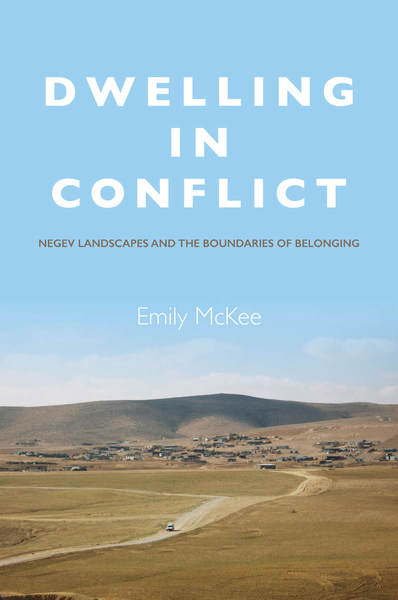You are here
Dwelling in Conflict: Negev Landscapes and the Boundaries of Belonging, by Emily McKee
VOL. 45
2015/16

Dwelling in Conflict: Negev Landscapes and the Boundaries of Belonging, by Emily McKee. Stanford, CA: Stanford University Press, 2016. 264 pages. $85.00 cloth, $24.95 paper and e-book.
REVIEWED BY NAYROUZ ABU HATOUM
The landscape in Palestine, like the land, is a site of political struggle. It is continuously being militarized, walled, and destroyed by a colonizing state. Beginning in 1948, through Zionist settler-colonial practices, the landscape in Palestine was profoundly transformed: villages and cities were destroyed and the Palestinian population displaced. Thus, today, one of the objectives of Palestinian resistance is to reclaim visibility in the landscape and reestablish attachment to it. Emily McKee’s Dwelling in Conflict: Negev Landscapes and the Boundaries of Belonging is an important contribution to research on bedouins’ struggle over their land, landscape, and dwelling practices in the shadow of displacement and coerced urbanization in the Naqab/Negev.
McKee explores dwelling practices of two communities in the Naqab on the margins of the Israeli state: the Arab bedouin township of ‘Ayn al-‘Azm and the Jewish settlement Dganim (both communities’ names are pseudonyms). Historicizing the landscape in the Naqab, McKee describes Israeli state practices and policies that resulted in the displacement of bedouins and the establishment of Jewish settlements. Early government strived to modernize and “Judaize” the desert—its landscape and indigenous population—primarily through agricultural development, which made the settlement of Jewish immigrants possible. In the shadow of such policies, McKee insightfully argues that dwelling, for the bedouins, becomes politicized: dwelling is mastering the art of “patience”—sabr, associated with a slightly subtle form of resistance—and that of “steadfastness”—sumud, a politicized form of national resistance.
Chapter 1 juxtaposes dominant Zionist-Orientalist and counter-Zionist environmental discourses as competing narratives of land claims. Although McKee presents Zionist discourses of religious and national ties to the desert landscape through her conversations with Jewish settlers, she narrates Arab bedouin connection to the land/landscape more extensively. Zionist discourses framed the bedouin in the Naqab as “uncivilized” natives. However, this discourse failed to grant bedouins indigenous claims to land or to recognize their dwelling practices. The Orientalist attribution of “nomadism” enabled Israeli authorities to deprive bedouins of their land claims, and paradoxically, of their mobility. Thus, bedouin relations to the land are “rendered incomprehensible in the Israeli legal system” (p. 48).
In chapter 2, McKee explores the everyday dwelling practices of both the Dganim and ‘Ayn al-‘Azm communities. Although both communities face different forms of state discrimination and seek its redress, McKee is interested in how bedouins narrate the past and protest current legal norms of ownership. A key tension emerges between approaches taken by members of bedouin communities: the first is to seek state recognition and incorporation into the Israeli societal fabric; the second is to contest the state’s Zionist expansive desires in appropriating Arab lands, by producing a nationalist counterdiscourse. This tension is expanded upon in chapter 4, where McKee explores the Dganim community’s history and the pressure of place-making and participation in Zionist aspirations. In the 1950s, Jewish immigrants from India settled in Dganim while the majority of bedouins were expelled. In the years since, a combination of government neglect and agricultural difficulties left Dganim struggling economically. Notably, this did not shift Dganim’s racist discourses against their bedouin neighbors.
Despite the shared experiences of marginalization faced by both communities, McKee demonstrates how the persistence of racial division serves state interests in maintaining separation through both discourse and infrastructure. Regulating dwelling practices in the Naqab meant that the state kept the Jewish and bedouin communities segregated. Despite being on the margins of Israeli society, most Jewish settlements in the Naqab enjoy legal legitimacy while bedouins do not. Successive Israeli government policies of evicting bedouins from their lands and relocating them in townships were carried out despite bedouins’ protests. McKee identifies the repercussion of such practices as “de-cultural accommodation”—the abandonment of collective and tribal affiliations for individual subjectivities, which underlies the premise of inclusion of bedouins in Israeli society. Yet, McKee does not explore this deculturalization as a form of denationalization, through which bedouins are stripped of their Palestinian historical ties.
McKee highlights the tension between bedouin resistance and cultural loss in chapter 3, where she examines the ‘Ayn al-‘Azm community’s displacement and relocation into government-built, crumbling townships. As bedouins remain connected to dwelling through past losses and memories, the significance of traditional kinship ties is replaced with individualist and nuclear family ideals. Yet, despite the relocation, many bedouin cultural practices persist which, McKee explains, function as a form of resistance to state modernization and urbanization.
Engaging with critical questions concerning bedouins as indigenous communities in Israel, McKee attempts to trace how displacement and community-building function in the geographic proximity of a landscape shared by colonized and colonizer, contested through discourses and practices of dwelling that both contextualize and decontextualize belonging. Bedouin dwelling, despite state displacement and relocation, is an act of resistance and an adherence to indigenous ways of living. The author fails, however, to strongly connect practices of displacement of Naqab’s bedouin communities with the wider context of the colonization of Palestine, such as in the occupied Palestinian territories. These linkages were empirically invoked by McKee’s interlocutors, who claimed that Israel’s settlements, expansive policies, house demolitions, and displacement of Palestinians from their homes take place both inside Israel and in the Palestinian territories. The book hints at the racialization of bedouins in Zionist discourses, which invites further investigation, since Zionism is, nonetheless, a racial project.
____________________________________________________________________
Nayrouz Abu Hatoum is a PhD candidate in social anthropology at York University, Toronto. Her doctoral dissertation is titled Framing Absence: Visuals of the Wall and the Vanishing Landscape in Palestine.
